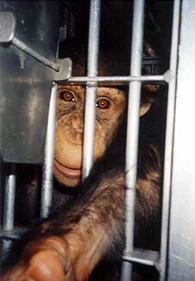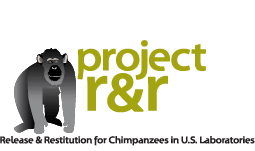At the end of his career, Dr. Moor-Jankowski began to doubt the necessity of using primates for experiments.
— Douglas Martin, The New York Times, September 3, 2005
At one point in its history, the Laboratory for Experimental Medicine and Surgery in Primates (LEMSIP) housed some 300 chimpanzees and nearly 300 monkeys. Chimpanzees and other nonhuman primates were subjected to intensive biomedical research in areas including reproduction, blood transfusions, hepatitis B and HIV.
LEMSIP was established in 1965 with the goal of becoming a federally funded primate research center for the New York area, but it remained a private laboratory until it closed in 1997. The lab, located in a wooded area north of New York City, was affiliated with New York University’s (NYU) School of Medicine.

Goliath at LEMSIP
Photo: © Nancy Megna
Six cages lined opposing walls of a windowless building; the cages were elevated for easy cleaning. The chimps could see one another, but were too far apart to have any contact. There was no outdoor holding or exercise area. The first time I was in that AIDS facility, it was horrifying; because a stranger had entered, the chimps screamed and spat and threw feces. It’s a cinderblock room, so if they really got going, slamming the bars of the cages, they could create a deafening sound. These chimps did not want to be there…. — Michael Nichols, Brutal Kinship
A paradox in care
Jan Moor-Jankowski, MD was LEMSIP’s founding director and remained in that position until shortly before it closed. Unlike most animal researchers, Moor-Jankowski was willing to interact with those critical of the use of animals. As a result, the lab became well-known to animal protectionists in the 1980s.
LEMSIP’s veterinarian, James Mahoney, had concerns about using animals that led him to encourage lab employees to work towards enriching their lives before enrichment was required.
Yet despite the goodwill towards animal advocates and attempts at humane considerations for the chimpanzees and other primates, the realities of laboratory life were quite cruel. Along with facing the most invasive of biomedical research, chimpanzees at LEMSIP were subjected to a myriad of miserable conditions:
- Most of the chimpanzees were housed singly in small, steel lab cages that hung above the floor. Moor-Jankowski theorized that allowing feces and urine to fall out of the cages would maintain a healthier environment, rather than hosing down the cages, causing dampness - a contributor to the widespread upper respiratory problems in captive primates. In reality, the cage design caused a permanent foul stench from excrement beneath cages. Even though it was removed regularly from the large plastic sheaths, it still forced chimpanzees to breathe in fetid odors day in and day out.
- Chimpanzees were denied any outdoor access. Moor-Jankowski believed that this would limit their germ exposure. While his reasoning is suspect, he also apparently gave little thought to how this might affect their mental health or sense of well-being.
- Adult chimpanzees were given little enrichment.
- Infant chimpanzees were taken from their mothers and raised by human caregivers to accustom them to being handled for procedures.
- Chimpanzee mothers were bred repeatedly to churn out babies for research, yet never allowed to raise their children past one year.
Roger Fout’s account of chimpanzees once used in pioneering sign language studies, but ultimately abandoned to LEMSIP (from his book Next of Kin):
…the chimps did not stop signing, though the technicians didn’t understand them. We heard from visitors that Booee, Bruno, Ally, and others kept asking the techs in ASL [American Sign Language] for food, drinks, cigarettes, and the keys to their cages….
…In my eyes, there was no difference between Pan, who couldn’t sign at all, and Booee, who knew thirty signs. Or between Manny, who had two signs - COME HUG - and Ally, who had 130 signs. All of the chimps felt the same pain of loneliness and a terrible fear about their strange new surroundings. Each of them had the same deep need that you or I would for the comfort of physical contact and affection. That was the tragedy of putting these social creatures in solitary cages that dangled above the floor. Ally and Nim weren’t suffering because they knew sign language; they suffered because they were chimpanzees.
…As we left LEMSIP… I was overwhelmed by shame. I was ashamed of Booee’s hepatitis, ashamed of the professionalism of Moor-Jankowski and myself, ashamed of the respectability that hung over all this suffering.
Moor-Jankowski and NYU: an escalating struggle
An outspoken man, Moor-Jankowski developed a controversial relationship with NYU, which would eventually have consequences for the primates at LEMSIP.
Beginning in the early 1980s, he was involved in a defamation suit stemming from his role as editor of the Journal of Medical Primatology. Moor-Jankowski permitted the publication of a controversial letter-to-the-editor written by Dr. Shirley McGreal, president of the International Primate Protection League. McGreal’s letter criticized the capture of wild chimpanzees for hepatitis research. This publication caused Moor-Jankowski to come under widespread condemnation from the animal research community.
Later, after NYU withheld funds earmarked for increasing the size of the lab’s chimpanzee cages to comply with regulations, Moor-Jankowski filed a complaint against his employer with the United States Department of Agriculture (USDA) highlighting the deficiencies.
Finally, in the early 1990s, the USDA charged NYU with 378 violations of the Animal Welfare Act at a separate university lab. The charges were in regard to water deprivation and other cruel treatment of monkeys used in addiction experiments. The charges stemmed from Moor-Jankowski having revealed information to the USDA about problems at that lab.
1997: NYU shuts down LEMSIP
In 1995, NYU reacted to Moor-Jankowski and LEMSIP by suddenly announcing that it would close LEMSIP and give all its primates to the Coulston Foundation (Coulston). NYU made this decision with full knowledge that the USDA had filed formal charges against Coulston for the negligent deaths of chimpanzees and monkeys. Soon afterwards, Moor-Jankowski was unceremoniously fired from his position as LEMSIP’s director for 30 years.
More research or the promise of sanctuary?
In 1997, the LEMSIP chimpanzees were sent to Coulston, but not before Jim Mahoney, D.V.M., Ph.D, LEMSIP’s veterinarian and acting director, managed to place 109 chimpanzees and 100 monkeys in sanctuaries around North America, including the Fauna Foundation, Wildlife Waystation and the Primate Rescue Center.
In 2002, most of the LEMSIP chimpanzees sent to Coulston were rescued by the Center for Captive Chimpanzee Care, now known as Save the Chimps, when it took over Coulston. However, an unknown number remain incarcerated in lab cages, transferred to the Alamogordo Primate Facility, which is owned by the National Institutes of Health (NIH) and operated under contract by Charles River Labs.
A change of heart
On August 27, 2005, Dr. Jan Moor-Jankowski died at the age of 81. Personal acquaintances report that he expressed a change of heart about using chimpanzees for biomedical research. A memorial fund has been established by his family, part of which has been designated to donate funds to retirement centers that received the former chimpanzees at LEMSIP. (3)
Sources
(1) In Defense of Animals, Chronology - Retaliation Case of Jan Moor-Jankowski, MD, August 14, 1996.
(2) Blum, Deborah. The Monkey Wars (New York: Oxford University Press, 1994), 166-179.
(3) Martin, Douglas. Jan Moor-Jankowsk, 81. Obituaries, The New York Times, September 3, 2005.

